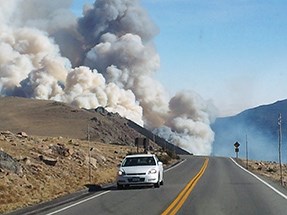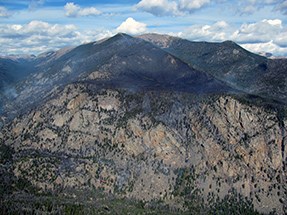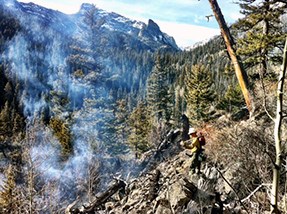Last updated: December 14, 2017
Article
Fern Lake Fire Offers Challenges and Opportunities in Rocky Mountain NP

“It all goes back to not putting people [firefighters] in places where they don’t need to be--it’s not worth the risk. Trees and shrubs grow back, people don’t. We had plans in place to take action where we had the most potential to be successful and where we had reduced the risk to a more acceptable level.”—Paul Cerda, initial attack incident commander, Rocky Mountain National Park

From the first signs of smoke from the Fern Lake fire in Rocky Mountain National Park (ROMO) on October 9, 2012, initial attack Incident Commander Paul Cerda knew a couple of key factors would drive the decisions on how to manage the fire. The fire was initially burning in steep terrain with heavy beetle-killed timber and hazardous trees. Cerda knew that full suppression through direct attack would put firefighters at unnecessary risk.
Taking action through indirect attack was necessary, but the town of Estes Park, park infrastructure, and the YMCA of the Rockies were situated precariously downwind from the fire.
Cerda and the limited crew of firefighters on hand were facing a more immediate challenge. The fire was burning toward one of the most popular visitor use areas of the park, and two empty school buses sat at the Fern Lake Trailhead.

“We discovered we had two busloads of third-graders out on the trail, so my first thought was getting the kids safely out of there,” Cerda said. “We didn’t know where they were on the trail, but even with the limited number of firefighters on scene, I assigned firefighter James Champ (who became operations chief later in the fire) to find the school groups and escort them out so we would know where they were and that they were safely evacuated.”
Schoolchildren weren’t the only ones enjoying a fall day in the park. An elderly couple had hiked up to Fern Falls. Several people were camped at the Moraine Park Campground, which was also downwind from the fire. Park rangers coordinated with the fire staff to ensure that the area, including a nearby livery, campground, and multiple trails, was safely evacuated.
Within 2 ½ hours of the initial fire report, the area had been evacuated. The fire was steadily growing, so Cerda worked with Fire Management Officer Mike Lewelling to plan their actions on the fire.
“We planned a full suppression from the start of this fire,” Cerda said. “We knew it was probably human-caused, given the point of ignition was down low in the drainage, not in an area we typically see lightning strikes. Our number one consideration was firefighter and public safety, and with that several factors come into play.”
Those factors included the late season and relatively late-in-the-day start of the fire, current and predicted weather and fire behavior, and firefighting resources available.
“The fire made a big push that first day, growing to more than 300 acres, but all indicators pointed toward significantly slower fire growth over the next several days,” Cerda added. “We had time to plan and attack the fire on our terms.”
Firefighters who had hiked into the fire area recommended ordering four hotshot crews--the most experienced crews in wildland fire--due to steep terrain, thick timber stands, and beetle-killed timber. They also requested two strike teams of five engines each that would provide support to the hotshot crews from more accessible areas, as well as structure protection if necessary.
Cerda ordered an air attack plane for “eyes in the sky” over the fire to provide intelligence, as well as a single-engine air tanker (SEAT) to drop retardant that slows the spread of a fire, buying time for firefighters on the ground to establish firebreaks. An actual retardant drop from the SEAT was not needed and would not have been effective due to weather conditions.
The National Park Service has a minimal impact approach to wildland fires, especially in designated wilderness areas such as in Rocky Mountain National Park. Typical firefighting tactics can leave behind scars beyond what the actual fire would cause. For instance, Cerda said, having firefighters in the heavy stands of beetle-killed timber would not only be a hazard to the firefighters, but it would also mean they would have to carve out helicopter landing spots to prepare for possible evacuation of injured firefighters. It would mean digging firelines and using chainsaws--in other words, leaving a substantial mark behind.
“We looked at the values at risk, which really were the watershed and the natural resources,” Cerda said. “In reality, we would have been doing more damage to them without a high probability of success, even if all the firefighting resources were available. It just didn’t make sense to expose firefighters to that risk, especially without any real benefit.”
What made sense was to step back and implement a plan to catch the fire when it came out of the backcountry.
“We decided to engage this fire on our terms, when the time was right, where probabilities of success were high and the risk was acceptable,” said Lewelling. This meant taking an indirect attack on the fire, scouting out firelines by using existing trails, putting firelines on ridgetops away from hazardous beetle-killed trees. And it meant using minimal impact suppression tactics that don’t scar the landscape, such as leaving only 1-inch high stumps when falling trees; scratching fireline with hand tools as opposed to bulldozers; and using retardant only when lives are at stake.
Firefighters also had an advantage by tying into existing prescribed fire and hazardous fuels treatment areas that already provided a buffer between the fire and the community. Because reduced fuel loading in those treated areas and firelines had already been created on the units, firefighters had confidence that they could directly, and safely, attack the fire in the Upper Beaver Meadows area.

For nearly two months, fire managers had ramped up resources and took action on the fire where it was safest to do so, then dropped back into a monitoring mode four times when snow or precipitation fell on the fire. November 2012 was the driest in 103 years, and despite efforts to suppress the fire, both from the air and with ground firefighters, on Thanksgiving Day, the Fern Lake fire flared up again in Forest Canyon, prompting heavier staffing. On November 27, with stiff winds and single-digit humidity readings, the fire made a push toward the confluence of Spruce and Forest canyons, so fire managers again ordered what resources were available, including Boise Smokejumpers and crews or modules from South Dakota, Wyoming, and western Colorado.
On December 1, the fire reached the trigger points. Fueled by 75 mph wind gusts and critically dry conditions, the fire ran three miles in 35 minutes just after 1:00 a.m., blowing past both management action points so quickly that it prompted an immediate evacuation of more than 600 homes. Firefighters took a stand at Moraine Park, back firing from Bear Lake Road to successfully stop the forward progression of the fire.

After the December 1st run, Type 3 incident commander trainee Mark Mendonca ordered multiple resources, including airtankers, helitankers, hotshot crews, hand crews, engines, and a Type 1 incident management team. The park also ordered two feller-bunchers (specialized logging equipment) to remove trees along the park roads and around some structures. The firelines held through two more wind events, and after snowfall December 8, most resources were demobilized.
Because of the threat to the community and the evacuations, the park was proactive in meeting with the community and being transparent about the decisions regarding the management of the fire. Given the opportunity to ask questions, many people did, and for the most part, they were satisfied with the answers.

“It all goes back to not putting people (firefighters) in places where they don’t need to be--it’s not worth the risk,” Cerda said. “Trees and shrubs grow back, people don’t. We had plans in place to take action where we had the most potential to be successful and where we had reduced the risk to a more acceptable level. When the fire behavior warranted it, we ordered airtankers and everything else we needed to protect the community. The real success lies in the fact that we have had no serious injuries on this fire.”
As of December 13, 2012, the Fern Lake fire was 3,498 acres. The fire destroyed one private cabin inside the park, but had not left the park boundary. Due to extremely dry fuels, heavy fuel loading, and deep duff layers, the fire will likely continue burning into the spring away from structures in the Forest Canyon area.
Contact: Mike Lewelling, Rocky Mountain National Park fire management officer
Email: e-mail us
Phone: (970) 586-1287 (office) or (970) 232-5326 (cell)
Contact: Traci Weaver, fire communication and education specialist
Email: e-mail us
Phone: (307) 739-3692 (office)
